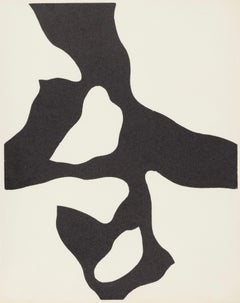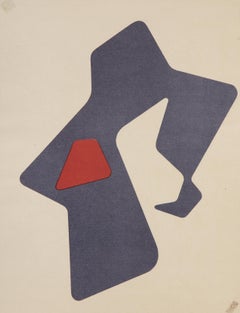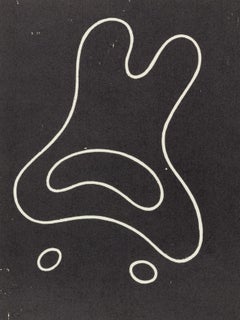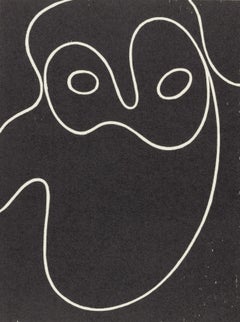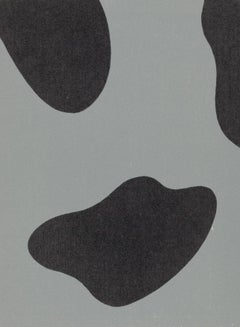Jean Arp
Jean Arp was born Hans Arp on September 16, 1886, in Strasbourg. In 1904, after leaving the École des Arts et Métiers, Strasbourg, he visited Paris and published his poetry for the first time. From 1905–07, Arp studied at the Kunstschule, Weimar and in 1908 went to Paris, where he attended the Académie Julian. In 1909, he moved to Switzerland and in 1911 was a founder of the Moderner Bund group there. The following year, he met Robert and Sonia Delaunay in Paris and Wassily Kandinsky in Munich.
Arp participated in the Erste Deutsche Herbstsalon in 1913 at the gallery Der Sturm, Berlin. After returning to Paris in 1914, he became acquainted with Guillaume Apollinaire, Max Jacob, Amedeo Modigliani and Pablo Picasso. In 1915, he moved to Zurich, where he executed collages and tapestries, often in collaboration with his future wife Sophie Taeuber (who became known as Sophie Taeuber-Arp after they married in 1922).
In 1916, Hugo Ball opened the Cabaret Voltaire, which was to become the center of Dada activities in Zurich for a group that included Arp, Marcel Janco, Tristan Tzara, and others. Arp continued his involvement with Dada after moving to Cologne in 1919. In 1922, he participated in the Kongress der Konstruktivisten in Weimar and the Exposition Internationale Dada at Galerie Montaigne in Paris. Soon thereafter, he began contributing to magazines such as Merz, Mécano, De Stijl and later, to La Révolution surréaliste.
Arp’s work appeared in the first exhibition of the Surrealist group at the Galerie Pierre, Paris in 1925. In 1926, he settled in Meudon, France. In 1931, Arp was associated with the Paris based group Abstraction-Création and the periodical transition. Throughout the 1930s and until the end of his life, he continued to write and publish poetry and essays. In 1942, he fled Meudon for Zurich after which he was to make Meudon his primary residence again in 1946. The artist visited New York in 1949 on the occasion of his solo show at Curt Valentin’s Buchholz Gallery. In 1950, he was invited to execute a relief for the Harvard Graduate Center in Cambridge, Massachusetts. In 1954, Arp received the Grand Prize for Sculpture at the Venice Biennale. A retrospective of his work was held at the Museum of Modern Art, New York in 1958, followed by another at the Musée National d'Art Moderne, Paris in 1962. Arp died on June 7, 1966, in Basel.
Find original Jean Arp art on 1stDibs.
| Average Sold Price |
| $1,329 |
| Styles |
| Materials |
| Related Artists |
1960s Abstract Jean Arp
Bronze
1950s Modern Jean Arp
Woodcut
1950s Modern Jean Arp
Lithograph
1960s Abstract Jean Arp
Engraving
1950s Modern Jean Arp
Woodcut
1950s Modern Jean Arp
Woodcut
1950s Modern Jean Arp
Woodcut
1930s Modern Jean Arp
Linocut
Jean Arp Sale Prices
| Sold Date | Sold Price | Category | Medium | Creation Year | ||||||||||||||||
|
| $1,329 |
Average sold price of items in the past 12 months |
| $695-$1,800 |
| Sold price range of items in the past 12 months |
Artists Similar to Jean Arp
Jean Arp art for sale on 1stDibs.
- What did Jean Arp believe?1 Answer1stDibs ExpertApril 5, 2022Jean Arp believed that the natural world was governed by logic and chaos and that attempts to regulate or control societies were ridiculous because of that. His Dadaist sculptures seek to communicate these beliefs. On 1stDibs, shop a collection of Jean Arp art.
- 1stDibs ExpertApril 5, 2022Jean Arp is a German-French sculptor and painter known as Hans Arp in German-speaking countries. Arp is best known for his sculptures, which were characterized by smoothly rounded forms. Shop a collection of vintage and modern Jean Arp pieces on 1stDibs.
- 1stDibs ExpertOctober 15, 2024Yes, Jean Arp was a Surrealist artist. His work actually appeared in the first exhibition of the Surrealist group at the Galerie Pierre in Paris in 1925. The German-French sculptor, painter and poet was also associated with Dadaism. Some of his most famous works include Danger of Death, Human Concretion and Torn-Up Woodcut. On 1stDibs, find a variety of Jean Arp art.

